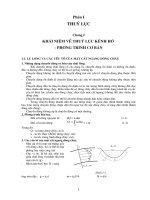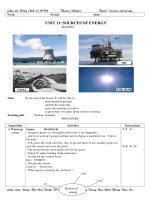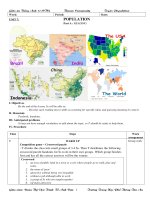Bài giảng thủy lực - Tiếng anh - P1
Bạn đang xem bản rút gọn của tài liệu. Xem và tải ngay bản đầy đủ của tài liệu tại đây (357.79 KB, 5 trang )
NONLINEAR PHENOMENA IN HYDRAULIC SYSTEMS
Satoru Hayashi
Professor Emeritus, Tohoku University, 981-3202, Sendai, Japan
ABSTRACT
Hydraulic systems include various non-linearities in
static and dynamic characteristics of their components.
Consequently, a variety of nonlinear phenomena occur
in the systems. This paper deals with intrinsic
nonlinear dynamic behaviors of hydraulic systems.
KEYWORDS
Hydraulics, Nonlinear phenomena, Hard self-
excitation, Micro-stick-slip, Chaos
INTRODUCTION
Hydraulic systems consist of various elements: pumps,
actuators, control valves, accumulators, restrictors,
pipelines and the like, which include many types of
nonlinearity, such as pressure-flow characteristics in
control valves, dry friction acting on actuators and
moving parts of valves, collision of valves against
valve seats. As a result, various types of nonlinear
phenomena arise caused by these non-linearities. It is a
marked feature of nonlinear systems that global
behaviors are sometimes quite different from local
behaviors. In such cases, results of linear analysis are
unavailable to estimate global nature of the system.
This paper focuses on the nonlinear phenomena
occurring in hydraulic systems, especially, “hard self-
excitation” [8] whose global stability drastically
changes from local one on the basis of the author’s
studies in the past [1]-[7].
HARD SELF-EXCITATION IN ASYMMET-
RICALLY UNDER-LAPPED SPOOL VALVE
[1],[2]
Spool valves are classified into three types, over-lap
valves, zero-lap valves and under-lap valves on the
basis of the relation of the land-width to the port-width.
They are used properly according to their applications.
Usually in spool valves, the supply side lap is equated
to the exhaust side lap, but the lap of the exhaust side is
often taken smaller than that of the supply side by error
in measurement in working or for stability purpose.
This type of spool valve is called ”asymmetrically
under-lapped spool valve”. Abnormal oscillations so-
called “hard self-excitation” are excited in hydraulic
servo-systems using this type of spool valve shown in
Fig. 1 [1].
“Hard self-excitation” is a kind of a self-excited
oscillation that occurs around a stable equilibrium point
by disturbances beyond a critical value and it is
distinguished from an ordinary self-excited oscillation
which occur around a unstable equilibrium point and is
called “soft self-excitation”. This situation is
demonstrated in Fig. 2, which shows the relation
between soft self-excitation and hard self-excitation by
bifurcation maps of amplitude and phase plane
trajectories of oscillations, where λ is a related system
parameter.
Fig. 1 Servo-system using asym-
metrically lapped spool valve
Fig. 2 Types of self-excitation, bifurcation
maps and phase trajectories
Fig. 3 shows responses of the cylinder of a hydraulic
system shown in Fig. 1 for different magnitudes of step
inputs given to a spool shaft of the system resting at the
neutral position, whose asymmetry lap ratio is
λ(= ε
e
/ε
s
)
= 0.047 (ε
s
=0.75mm) and the supply pressure
is P
s
= 9.5MPa. As shown here, the transient
oscillatory responses (a), (b) and (c) settle down to an
initial equilibrium position for relatively small inputs.
This shows the neutral position is locally stable.
However, the response (d) for larger inputs beyond a
critical valve develops into a finite amplitude
oscillation. This fact shows that the phenomenon is a
typical “hard self-excitation”[1].
Fig. 4 indicates a local stability map of the neutral
position of the system, which is calculated from the
following stability criterion Eq. (1) [2].
[ ]
>+
′
′
+
κκ
020
2
V
aMAABbMbB
V
(1)
and A is the cross-sectional area of the actuator, B the
damping coefficient, C
x
the leakage coefficient, M the
load mass, Q the flow rate of the valve and κ the bulk
modulus of oil.
The curve in Fig. 4 shows the critical supply
pressure against asymmetry ratio Λ(=1−λ). According
to the map, the system using a symmetrical lapped
valve λ=1 (ε
s
= ε
e
) is locally stable for the supply
pressure P
s
=5.9MPa. But for the system using a spool
valve with asymmetry lap ratio λ=0.047, the neutral
position is stable.
Equivalent asymmetry ratio (Λ=1−λ) is gradually
increases according to the increase of the spool
amplitude after the valve begins to move by input
disturbances, even though the system is stable at the
neutral position. The pressure-flow coefficient b in Eq.
(1) drastically increases as shown in Fig. 5. On the
other hand, the flow-gain a changes little. As a result,
the system becomes unstable and the oscillation is
excited. This is the mechanism of the “hard self-
excitation”. Taking into consideration this hard self-
excitation, the self-excited region is enlarged more than
locally unstable region that is between a solid line and a
dashed line as shown in Fig. 6.
Fig. 3 Responses of hydraulic servo-
system with asymmetrical spool valve for
different magnitude of step inputs
,
210
,2
0
2
0
1
,
0
where
VVV
d
C
e
Cbb
P
Q
P
Q
b
x
Q
a
==++=
′
∂
∂
=
∂
∂
−=
∂
∂
=
Fig. 4 Local stability map by asymmetri-
cal lap ratio
21
0
, PPP
P
Q
b
L
L
−=
∂
∂
=
Fig. 5 Pressure-flow coefficient
MICRO-STICK-SLIP IN SERVO-SYSTEM
USING UNDER-LAPPED SPOOL VALVE [3]
It is familiar to most hydraulic engineers that stick-slip
phenomenon occurs in a hydraulic system using an
actuator subjected to dry friction. It is shown in this
paper that there exists a quite different type of stick-slip
phenomenon [3] from the above mentioned in a
hydraulic servo-system using a spool valve with the
symmetrical under-lap ε
e
=ε
s
in Fig. 1, whose actuator is
affected by dry friction.
A global stability map of the system is plotted in Fig.
7, which indicates amplitudes of stable and unstable
self-excited oscillations for each supply pressure P
s
.
The neutral position is always locally stable for the
system with an actuator affected by dry friction. But
self-maintained oscillations are possible to occur for
large disturbances beyond critical values as seen in Fig.
7. This phenomenon is also “hard self-excitation”. The
solid lines AB and CD correspond to stable oscillations
and the dashed lines AE and BC to unstable ones. This
system has multiple stability construction, that is,
multiple oscillatory solutions for each supply pressure
in a certain region. The oscillation on CD is almost
sinusoidal as it is well known. However, a stick-slip
oscillation occurs on AB for input disturbances
between the curves AE and CB, which correspond to
amplitudes of unstable oscillatory solutions. The
amplitudes are small and do not exceed several
micrometers.
Fig. 8 shows simulated responses for different
magnitude inputs. Fig. 8 (c) corresponds to the stable
stick-slip oscillation. Unlike the ordinary stick-slip, the
difference between static and dynamic friction is not
essential for occurrence of this stick-slip. This is
novelty of the phenomenon.
HARD SELF-EXCITATION IN POPPET
VALVE CIRCUITS [4],[5],[6]
Poppet valve circuits are classified into two categories:
direct-acting type circuits and pilot type circuits [6]. It
is familiar to hydraulic engineers that poppet valves are
liable to become unstable and excite various self-
oscillations in both circuits. Fig. 9 shows a pilot type
poppet valve circuit. Fig. 10 indicates a stability map
of the circuit with a 0.6m supply line. The abscissa is
the supply pressure P
s
and the ordinate the valve lift X.
A hatched line is a boundary of stability and the system
is stable in the lower part of the curve. A thin solid line
represents a static characteristic for the cracking
pressure P
si
= 2 MPa, along which the valve lift moves
according to the supply pressure change P
s
.
Figure 11 indicate responses of the valve for
different magnitude inputs under a same operating
condition that is plotted by a mark A on Fig. 10. The
point A is in the locally stable region. Thus the
Fig. 7 Global stability map of hydraulic
servo-system with under-lapped spool
valve
Fig. 8 Responses of hydraulic system
Fig.6 Local and global stability map
transient response (a) for a small input die downs to a
steady point, while the response (b) for a little larger
input than the case (a) develops into a maintained
oscillation. This is a typical hard self-excitation around
a locally stable equilibrium point.
Figures 12 and 13 show another case of a hard self-
excitation occurring in a poppet valve circuit with a
0.3m length supply-line. A logarithmic scale is taken
to the ordinate of the map to enlarge the small valve lift
region. The dashed line represents a static
characteristic corresponding to a cracking pressure P
si
=
4MPa. As seen in this figure, the small valve lift
region including X=0 is locally stable for any supply
pressure. This means that the valve sitting on its seat at
any under-cracking supply pressure is locally stable.
But the result of Fig. 13 shows that the global behavior
is quite different from this local nature.
Figure 13 shows valve responses for different
magnitude disturbances, which are given to the valve
sitting on the seat at an under-cracking supply pressure
plotted by in Fig. 12. As seen in Fig. 13 (b), a
maintained oscillation is excited for a large disturbance.
This is also a typical “hard self-excitation” and this
phenomenon is interesting in that even the valve sitting
steadily on its seat has a possibility of occurrence of
self-excited oscillations.
Taking into consideration this “hard self-excitation”,
the self-oscillation region of the system significantly
expands as shown by a heavy line in Fig. 10.
CHAOS IN POPPET VALVE CIRCUIT [6],[7]
Another outstanding nonlinear phenomenon occurring
in hydraulic systems is chaotic oscillation [6].
All peak values of each oscillatory wave of self-
excited oscillations occurring in the same system as
Fig. 9 are plotted in Fig. 14. A dashed line AB
represents a static valve lift against the supply pressure
P
s
and the interval AB is a soft self-excitation region.
In the much lower supply pressure region under
cracking pressure P
si
, there is only one peak value
corresponding to the oscillation at each supply
pressure. This means that the oscillation has only a
period (period-one oscillation). As an increase in the
supply pressure, the period-one oscillation branch
bifurcates into two values (period-two oscillation) and
after that the branch bifurcates four values, eight
values,and 2
N
values. In the limit, peak
values compactly distribute in a limited range of the
valve displacement for a supply pressure. This implies
that the oscillation
is a Faigenbaum type chaos [6].
Furthermore, it is shown that other types of chaotic
oscillations, or Lorenz type chaos and intermittent type
chaos also appear in direct-acting poppet valve circuits
[7].
CONCLUSIONS
Nonlinear dynamic phenomena in hydraulic systems
are unique and diverse. It is difficult to estimate their
global nature from local nature by linear analysis.
Fig. 11 Responses for different magnitude
disturbances
Fig. 9 Schematic diagram of pilot type
poppet valve circuit
Fig. 10 Local and global stability map of
poppet valve circuit for L=0.6m
Analytical method is virtually impossible to solve
global dynamic problems of these nonlinear systems.
Numerical simulation is only one method available to
solve them. Almost all results described here were
obtained by use of numerical simulation. It is
inevitable to understand global nature about nonlinear
dynamic systems for the purpose of sophisticated
design of hydraulic systems. Thus it is expected that a
number of nonlinear problems in hydraulic systems
will be solved by numerical simulation.
REFERENCES
[1] Hayashi, S. et al., Hard Self-Excitation in Hydraulic
Servomechanism with Asymmetrically Under-lapped
Spool Valve, Transactions of the Society of Instrument
and Control Engineers, 1975, 16(3), 85-90 (in
Japanese).
[2] Hayashi, S. and Ohashi, T., Stability of Hydraulic
Servo-mechanism with Spool Valve, Transactions of
the Japan Society of Mechanical Engineers, 1986,
22(4), 459-464 (in Japanese).
[3] Hayashi, S. and Iimura, I., Effect of Coulomb
Friction on Stability of Hydraulic Servomechanism,
Proc. FLUCOME’88, 1988, 310-314.
[4] Hayashi, S. and Ohi, K., Global Stability of a
Poppet Valve Circuit, Journal of Fluid Control, 1993,
21(4), 48-63.
[5] Hayashi, S. et al., Chaos in a Hydraulic Control
Valve, Journal of Fluids and Structures, 1997, 11, 693-
716.
[6] Hayashi, S., Stability and Nonlinear Behavior of
Poppet Valve Circuit, Proc. FLUCOME’97, 1997, 1,
13-20.
[7] Hayashi, S. and Mochizuki, T., Chaotic Oscillations
Occurring in a Hydraulic Circuit, Proc.1st JHPS Int.
Symp. On Fluid Power, 1989, 475-480.
[8] Minorsky, N., Nonlinear Mechanics, Edwards
Brothers Inc., 1947, 71.
Fig. 12 Local stability map of pilot type
poppet valve circuit L=0.3m
Fig. 14 Bifurcation map of self-excited
oscillations
Fig.13 Responses for different magnitude
disturbances









